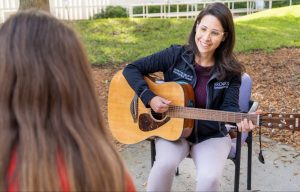The Harmony of Music Therapy
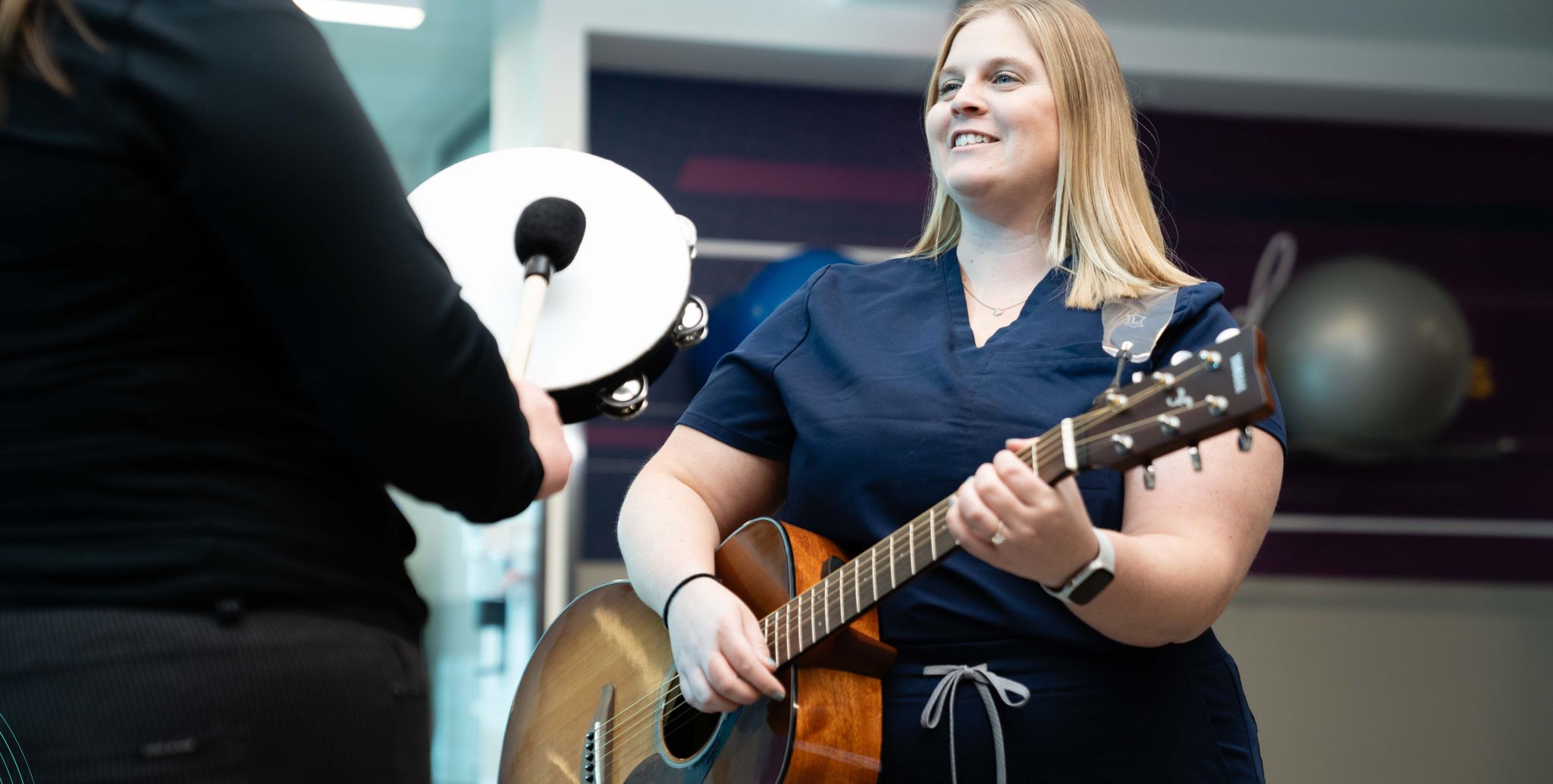
Back to physical health resource hub
Music has long been recognized for its ability to evoke emotions, memories and connections with others—and in the medical setting, music can have an incredible impact on our mental, emotional and even physical well-being.
Music therapy is a clinical and evidence-based practice that utilizes music interventions to address individualized therapeutic goals. The versatility of music therapy allows it to be used for a wide range of purposes, from promoting relaxation and stress reduction to improving cognitive and motor skills. Board-certified music therapists, like Brooks Rehabilitation’s Music Therapy Program Coordinator Danielle Porter, MM, MT-BC, are highly trained professionals who assess the needs of each client and develop a tailored plan to support their unique journey.
Music therapy is integrated into many parts of the Brooks system of care, and the music therapy program at Brooks utilizes neuroscience research to help patients who are receiving occupational, speech or physical therapy heal by addressing their physical, cognitive, speech, social and emotional needs.
“We frequently co-treat with physical, occupational and speech therapists at our hospital locations where our focus is on repetition, intensity and saliency to stimulate neuroplasticity,” said Porter. “Many of our colleagues report that their patients tolerate therapy better and can often reach their goals faster with the addition of music therapy.”
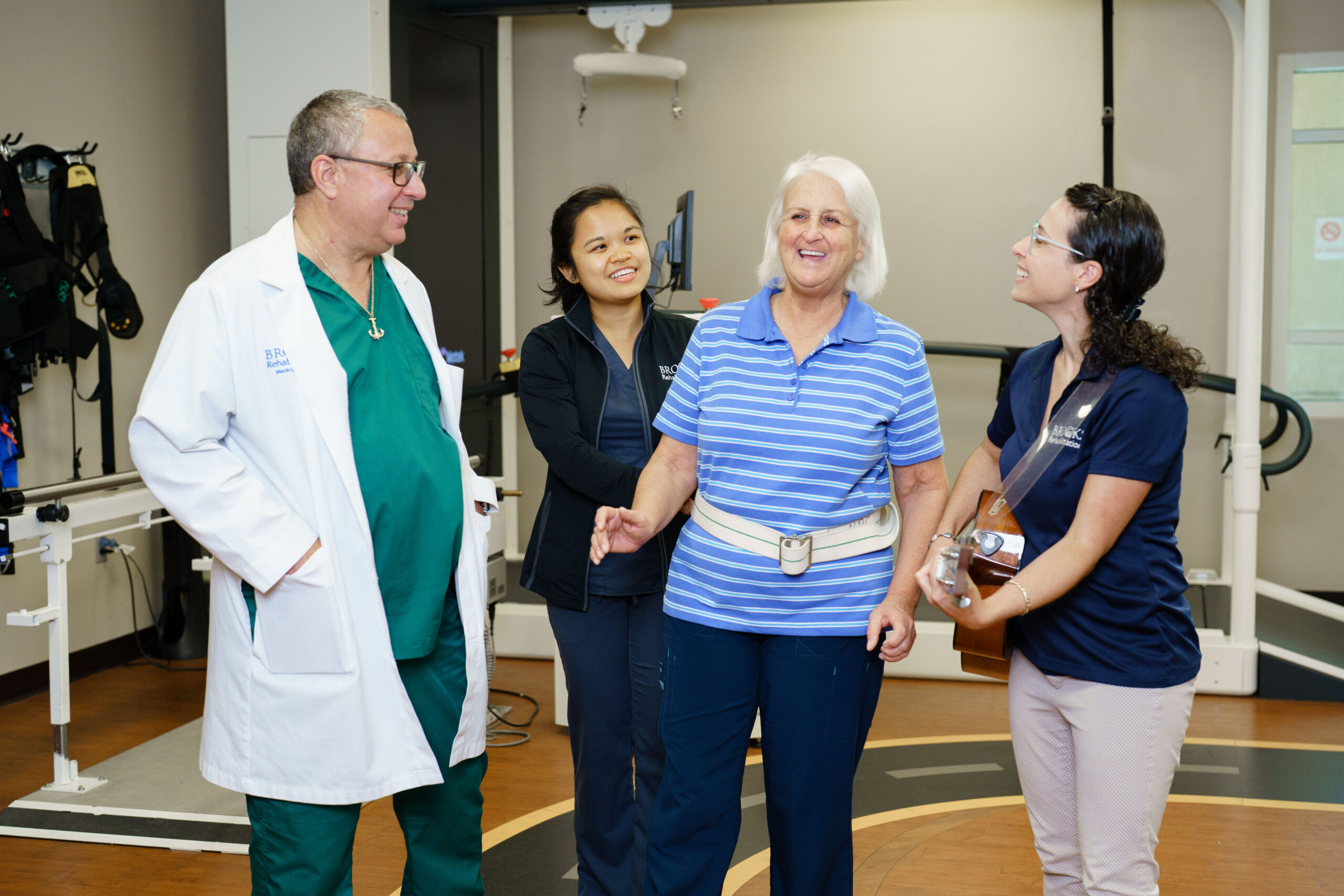
By using music, the brain can be leveraged to elicit different responses—whether it be motor, cognitive or language-based—which are not always observed in traditional therapies, making co-treatment between music therapy and other therapies beneficial.
Whether you are a music enthusiast, a healthcare professional or simply curious about the therapeutic power of music, we invite you to learn more about music therapy below.
What Makes a Song Therapeutic?
According to Porter, no specific song or beats per minute (BPM) is more therapeutic than others. Instead, when administering music therapy, a music therapist determines the songs used in a session by considering the patient’s age, preferences and goals of the session, among other factors.
For example, she says that when working with children in a session with goals that include direction following, movement, attention or sequencing, she often uses Laurie Berkner songs, such as “The Goldfish Song” or “We Are the Dinosaurs.”
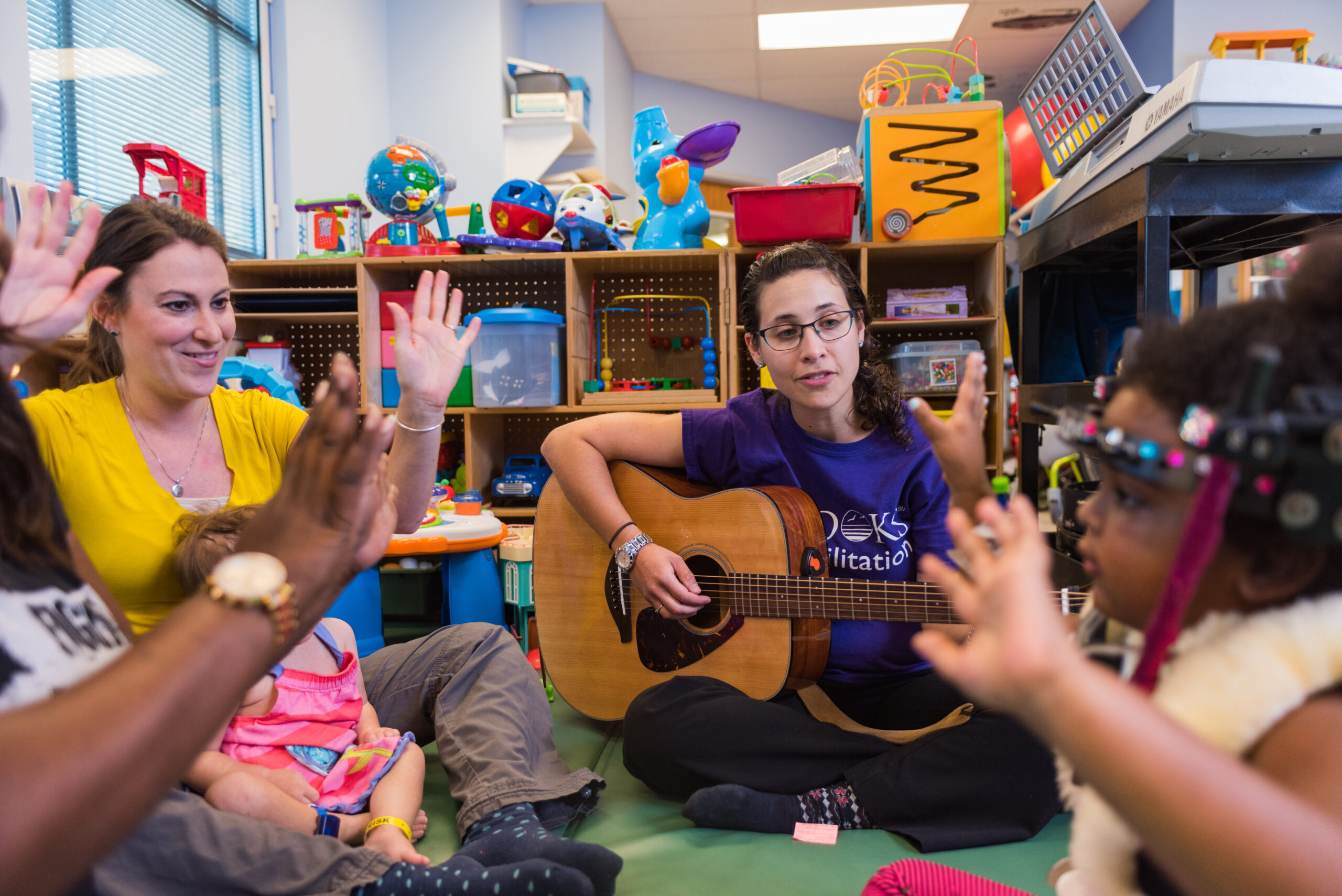
“When we do lyric analysis and songwriting with clients, there are some songs that are naturally more adaptable for the situation,” said Porter. “For example, a song I’ve used frequently to help clients process the gravity of their situation is ‘The Climb’ by Miley Cyrus. The lyric content is relatable to our patients, so this is something that we verbally work through as a means to process their emotions and feelings and develop healthy coping strategies.”
Most music therapists use the guitar or keyboard and their voice to facilitate sessions, and all music therapists must demonstrate proficiency in all of these domains in order to become board-certified. A variety of hand percussion instruments are incorporated as well, such as frame drums, tambourines and egg shakers.
In addition to utilizing instruments in live music therapy sessions, Porter says the field of music therapy collectively utilizes patient preferred music. Patient-preferred music is important as it engages and motivates the patient, and more brain activation occurs with preferred music versus non-preferred music.
Once the therapist knows the patient’s music preference, they can then select a song within that genre or from the artist that meets the need of the task. For example, if a patient is doing a seated exercise where they straighten their right leg for two counts, kicking a frame drum on count two, and return their foot to the floor by count four, the music therapist would need to select a song in quadruple meter with a strong pulse.
“I frequently use the playback feature on YouTube to slow a song down or speed it up by a quarter percent depending on the patient,” said Porter. “The more cues a patient needs for cognitive processing, the less inclined I am to use recorded music. If I decide to do live cues, I manipulate the elements of music—not just the meter but also the harmony, spatial cues and rhythm.”
Porter says that when working with individuals with dementia, therapists select songs that might relate to the person’s prior occupation, state of residence or a song symbolizing a significant event that may have occurred during their lifetime.
“We use these songs as a jumping point for reminiscing to allow the person to re-affirm their identity and recall salient memories from their life,” said Porter. “This provides these individuals much comfort, purpose and validation.”
While patient-preferred music is collectively utilized in the field, Porter highlighted instances where familiar songs may not be necessary or appropriate for the task. Rather, the music therapist may just play a standard chord progression.
For example, when doing ambulation training alongside physical therapy, music therapists use a technique called Rhythmic Auditory Stimulation. During this task, the therapist manipulates rhythm to prompt desired non-musical responses such as step size, stride length, stride symmetry and cadence.
Another instance where music therapists might manipulate the elements of music is when working with Parkinson’s patients.
“When working on walking with patients with Parkinson’s disease (PD), the general rule is to provide a live auditory cue that is slower than the patient’s demonstrated gait speed. This is because individuals with PD tend to have a quick, shuffling gait,” said Porter. “We are trying to slow them down and increase their step size to ultimately reduce their risk of falling.”
Benefits of Music Therapy
The benefits of music therapy will depend heavily on how it’s being utilized and in which settings. For example, in rehabilitation hospital settings, music therapy sessions may be more structured, therapist-led and goal-focused. Music therapy in community settings may be more improvised and address inclusion, emotions and socialization.
Music therapy can benefit individuals of varying abilities. Because music therapy addresses non-musical goals, outcomes for patients include but are not limited to the following improvements:
- Fine and gross motor coordination
- Strength
- Endurance
- Balance
- Ambulation
- Verbal expression
- Vocal range and intensity
- Respiratory strength
- Attention
- Processing speed
- Memory
- Executive functioning
- Anxiety
- Depression
- Coping skills
- Social skills
“Improvements in these areas translate to life beyond therapy,” Porter said. “For example, individuals may gain the skills they need to care for themselves independently, manage symptoms of disease, re-integrate into the community, and even resume work or school.”
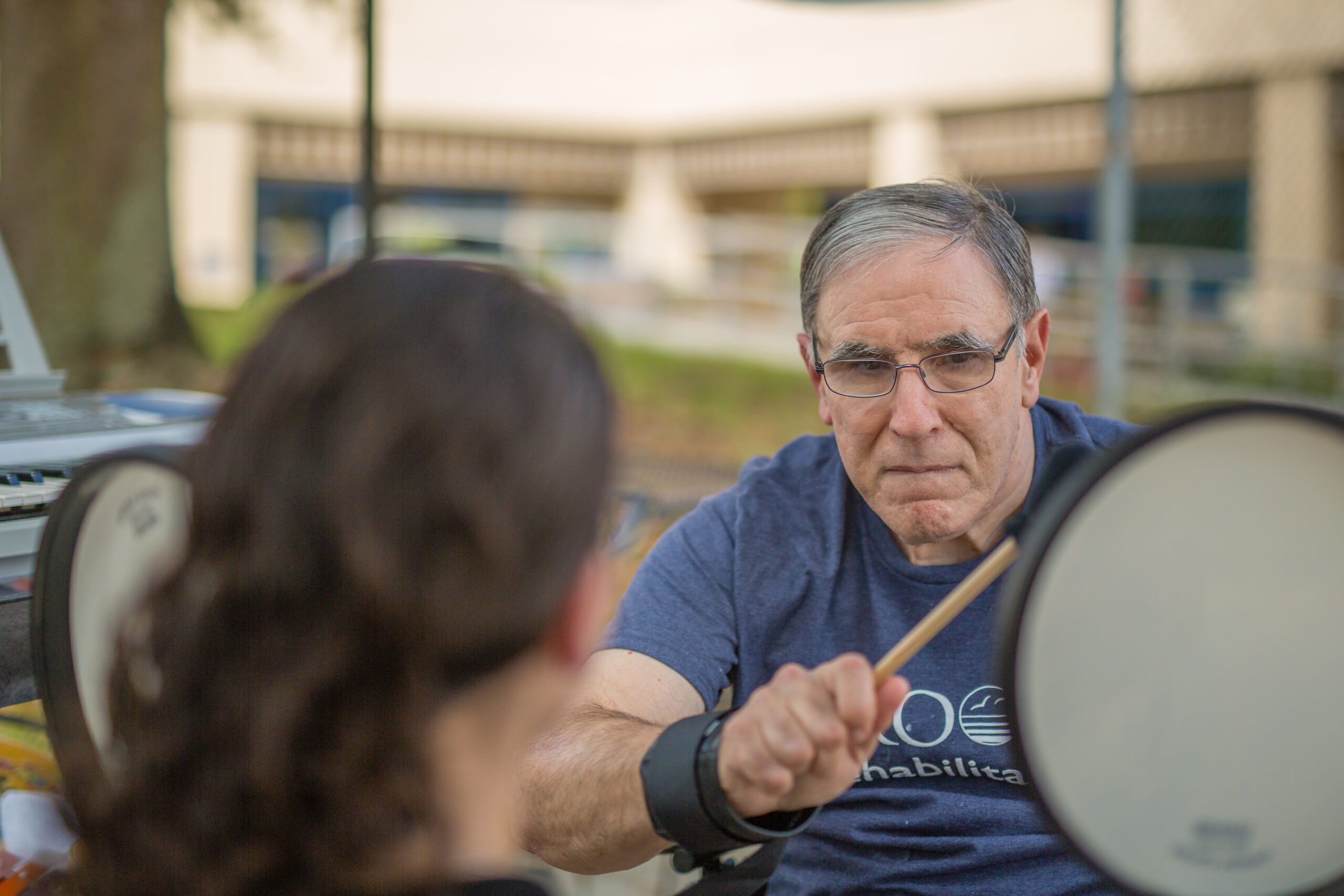
There are specific benefits with other patient populations, such as dementia. Research shows that individuals with dementia who receive weekly music therapy have better physical and mental states and lower blood pressure as they age compared with those who don’t. Music therapy can also lead to decreased use of psychotropic drugs to manage symptoms of dementia, such as agitation and wandering.
How Music Therapy Shapes Lives
Amy, an elementary school music teacher working to obtain her music therapist certification, was diagnosed with a brain tumor in 2021.
As she was recovering from surgery, she suffered complications from the brain tumor and needed to be resuscitated which resulted in a hypoxic injury to her brain. This necessitated two months in the ICU at Mayo Clinic Jacksonville followed by two months at Brooks Rehabilitation Hospital – University Campus. Although her understanding did not seem to be affected, she lost major motor control of her muscles and the ability to formulate words and annunciate sounds with her voice, lips and tongue. She was not able to talk or walk.
“Our daughter was also a musician and music teacher prior to her brain injury, and after her injury, she no longer had the ability to move other parts of her body to sing, play the keyboard or tap out a rhythm as she could prior to her injury,” said Amy’s father, David Dagenais.
According to Amy’s parents, while at Brooks, Amy received music therapy with speech, occupational and physical therapy. Amy responded to music therapy well, and when it was combined with any of the other therapy disciplines, she had much better results from the therapy session. Her parents said that music therapy, along with speech therapy, helped to give her the coaching she needed, utilizing melody to help her to develop the brain signals that were lost to move her muscles again.
“By having the opportunity to observe several of the music therapy sessions with Amy, we learned a great deal about music therapy as her parents and caregivers while she was trying to recover from her brain injury,” said Dagenais. “As Amy expressed to us, music therapy is not music for entertainment, music therapy is using music in the healing process, and it was eye opening to see it in action.”
Jennifer Norton was introduced to music therapy at Brooks with the Parkinson’s Choir, a choir group of Parkinson’s patients utilizing music therapy to overcome challenges associated with the disease. This choir program formed out of the culmination of a research study Porter completed with speech pathologists at Brooks and Jacksonville University in 2018.
She said the Brooks’ Parkinson’s Choir not only offered her the opportunity to sing, but it also allowed her to develop crucial friendships and make connections with other Parkinson’s patients, opening up additional opportunities that wouldn’t have been possible if not for the music therapy program.
“Besides the social aspect, which has been life changing, there are also the health benefits that come from singing when you have Parkinson’s,” said Jennifer Norton. “I can’t list all of them, but I have known many Parkinson’s patients that have lost their ability to speak clearly. I have had the disease for 18 years, and although I am soft-spoken, I have no problems communicating. I give credit to the music therapy program for this.”
How To Create Your Own Exercise Playlist, According to a Music Therapist
The first step to creating your exercise playlist is to consider which songs speak to you. Next, because rhythm is intrinsic and helps drive movement, Porter says that a song’s pace, or BPM, is another crucial detail when curating a workout playlist.
“Our brains respond to rhythm by processing it through the auditory cortex and other neurologic systems tell our bodies to move with the beat,” said Porter. “The whole process is incredibly intrinsic, especially because walking is already a rhythmic task and because our brains have a feed-forward process, meaning they can anticipate the beat once an external stimulus is presented.”
When creating your own playlist, Porter recommends starting with a warm-up at a slower BPM with each song gradually increasing in BPM until you reach the target heart rate BPM.
“If working on endurance, an individual can work out with songs at that target BPM for 20 minutes, for example. Then, as they begin to warm down, they can select songs with lesser BPM,” said Porter.
Take the following steps to create your own playlist for exercise:
- Add your favorite songs to the playlist. The length of the playlist will be the length of your workout (e.g., a playlist with 30 minutes of music is equivalent to a 30-minute workout).
- Determine your target heart rate in BPM. To calculate this, subtract your age from 220.
- Search the internet for the BPMs of each of the songs in your playlist. Write these numbers down.
- Build a warm-up section consisting of songs with a slower BPM.
- Gradually increase the BPM with each song until you reach your target heart rate BPM. Include songs at this BPM for the endurance portion of your workout (e.g., 20 minutes).
- Finally, add songs with a decreasing BPM for the warm-down section.
- Listen through your playlist and make any necessary adjustments to ensure a smooth transition between songs and a consistent progression towards your goals.
Music Therapist Recommendations on General Wellness and Exercise Playlist
For rock n’ roll lovers who want to focus on bettering their cardiovascular health, Brooks has created a playlist for general wellness and exercise uses that anyone can enjoy.
Featuring songs “Here Comes the Sun” by The Beatles and “Good Vibrations” by The Beach Boys, the playlist seamlessly guides listeners through a one-hour-long workout of their choice, including a warm-up and cool-down section. With the help of Music Therapy Program Coordinator Danielle Porter, explore the curated playlist below.
Listen to the full playlist on Spotify
For more information about the music therapy program at Brooks or to get involved with one of our community-based programs, visit our music therapy page here.

